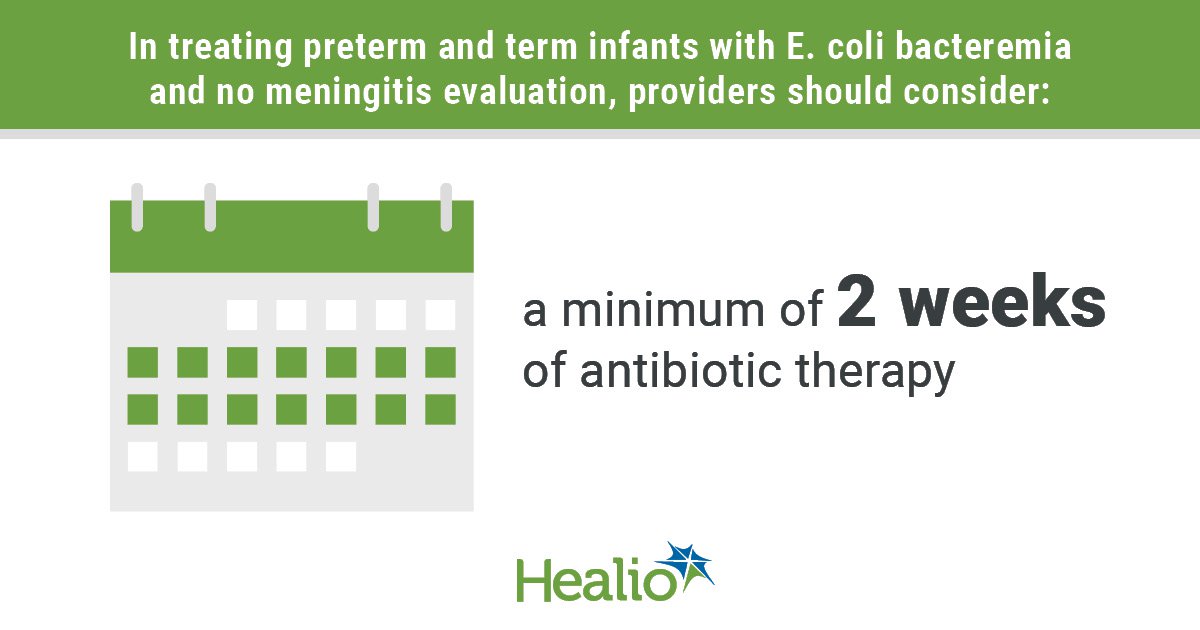Key takeaways:
- Research has shown that shorter courses of antibiotics are noninferior to longer courses for some infections.
- A study presented at PAS showed that was not the case for E. coli bacteremia in the NICU.
TORONTO — Shorter courses of antibiotics were associated with increased odds of reinfection and death among infants treated in the NICU for Escherichia coli bacteremia who were not evaluated for meningitis, a study showed.
Researchers who presented the findings at the Pediatric Academic Societies meeting said providers should consider a minimum duration of 14 days of antibiotic therapy for these patients.
Data derived from Stark A, et al. Duration of therapy for Escherichia coli bacteremia without CSF evaluation in the NICU: Is shorter better? Presented at: Pediatric Academic Societies Meeting; May 2-6, 2024; Toronto.
Many studies have showed that shorter courses of antibiotics are just as effective as longer courses for certain infections, including those that impact children — an idea that has come to be called “shorter is better.”
“Infection is a leading cause of mortality in infants, and gram-negative rod bacteremia particularly is associated with higher rates of mortality,” Ashley Stark, MD, MS, a neonatology fellow at Duke University School of Medicine, told Healio. “E. coli is one of the most common cause of gram-negative rod bacteremia in infants, the most common cause of early onset bacteremia, and often a cause of late onset. However, we don’t know the optimal duration of antibiotic therapy in these infants.”
Stark and colleagues retrieved data from over 400 NICUs and 1.6 million patients in the United States to find infants with first instance of E. coli bacteremia between 1997 and 2020 who were initiated on antibiotics within 2 days of an index culture.
Their study included 983 of these infants who were not evaluated for meningitis — something that is often deferred in infants with bacteremia because of concerns of clinical instability, the researchers noted.
They compared participants’ in-hospital mortality and a combination of recurrence of infection or death based on three lengths of antibiotic course — patients who received fewer than 14 days, 14 to 21 days, or more than 21 days of therapy.
The results painted a “stark contrast” between the cohorts, Stark said.
Altogether, 44% of infants received fewer than 14 days of antibiotics, 30% received 14 to 21 days of therapy, and 26% received 21 or more days of treatment.
, infants who received 14 to 21 days of antibiotics or more than 21 days were far less likely to experience the combined outcome of recurrence of infection or death, with ORs of 0.14 (95% CI, 0.09-0.22) and 0.2 (95% CI, 0.13-0.31), respectively, compared with infants who received less than 14 days of therapy.
In another cohort of 624 infants with E coli bacteremia who underwent a CSF evaluation with a negative culture and no pleocytosis, antibiotic durations of shorter than 14 days were not associated with worse outcomes, Stark said.
“However, in the cohort in which a CSF was not obtained, shorter durations of antibiotic therapy were associated with higher mortality compared to infants who had longer durations of antibiotic therapy,” she said.
Stark said a prospective study is needed to confirm the findings.
“Although we showed that there was no increase in mortality in infants with E. coli bacteremia who did undergo a CSF evaluation, we don’t know the exact number of days for antibiotic therapy that is appropriate since we grouped our antibiotic durations into three categories,” Stark said. “Is it 10 days? Fourteen days? Future studies would also need to clarify this important question.”
